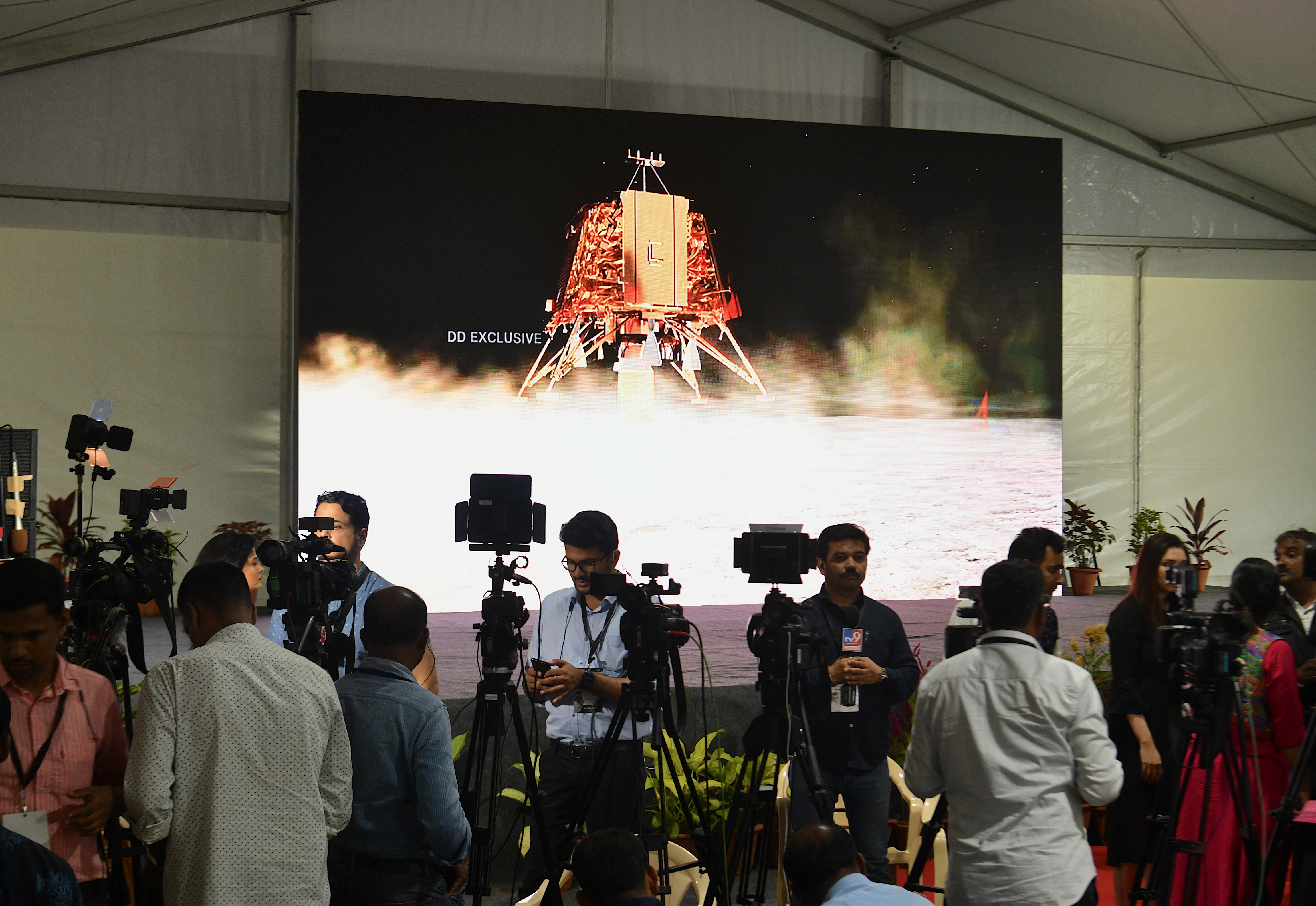
Members of the India media cover the developments at ISRO Telemetry Tracking and Command Network (ISTRAC) facility in Bangalore, on September 6, 2019, as the countdown for the soft-landing of Vikram lander of Chandrayaan-2, on the surface of the moon is expected to happen in the early hours of September 7. – Chandrayaan-2 space exploration mission consisting of a lunar orbiter, a lander named Vikram, and a lunar rover named Pragyan, all of which were developed in India, was launched from Satish Dhawan Space Centre in Sriharikota on 22 July 2019 by the Geosynchronous Satellite Launch Vehicle (GSLV) Mark III. (Photo by Manjunath Kiran / AFP)
BANGALORE, India — India lost communication with its unmanned spacecraft Saturday just before it was due to land on the Moon, in a blow to the country’s lunar ambitions as the world takes renewed interest in Earth’s satellite.
While Prime Minister Narendra Modi looked on in the mission control room at the southern city of Bangalore, India had hoped to become just the fourth country — after the United States, Russia and China — to successfully land on the Moon.
But following several tense minutes as the expected landing time of about 1:55 am in New Delhi (2025 GMT) lapsed, Indian Space Research Organization (ISRO) chairman Kailasavadivoo Sivan announced that communication had been lost with the lander.
“The ‘Vikram’ lander descent was (ongoing) as planned and normal performance was observed,” until an altitude of 2.1 kilometers (1.3 miles), Sivan said.
“Subsequently the communication from the lander to the ground station was lost. The data is being analyzed,” he said, surrounded by grim faces of scientists and observers in the control room.
Modi told scientists after Sivan’s announcement that “what you have done (already) is not a small achievement”.
“Ups and downs keep coming in life. Your hard work has taught us a lot and the entire country is proud of you,” he added.
“If the communication (with the lander) starts again… hope for the best… Our journey will carry on. Be strong. I am with you.”
ISRO had acknowledged before the landing that it was a complex manueuvre,which Sivan called “15 minutes of terror.”
“It is like suddenly somebody comes and gives you a newborn baby in your hands. Will you be able to hold without proper support?,” he told news channel NDTV.
“The baby will move this way, that way but we should hold it,” Sivan said.
The lander, named after Vikram A. Sarabhai, the father of India’s space program, aimed to the first to reach the region lunar South Pole region.
Indian scientists were eyeing more than just national pride from the mission.
The lander was carrying rover Pragyan, wisdom in the Sanskrit language, which was due to emerge several hours after touchdown.
The rover was expected to explore craters for clues on the origin and evolution of the Moon, and also for evidence on how much water the polar region contains.
The orbiter remains in operation and will continue to study the Moon from afar for about a year.
Low-cost
According to Mathieu Weiss, a representative in India for France’s space agency CNES, analyzing the South Pole was vital to determining whether humans could one day spend extended periods on the Moon.
And if people can survive on the Moon, then this means it could be used as a pitstop on the way to Mars, the next objective of governments and private interests such as Elon Musk’s Space X.
Asia’s third-largest economy also hopes to secure lucrative commercial satellite and orbiting deals in the competitive market.
The Chandrayaan-2, or Moon Chariot, mission also stood out because of its low cost of about $140 million. The United States spent the equivalent of more than $100 billion on its Apollo missions.
India is also preparing Gaganyaan, its first manned space mission, with the air force announcing Friday that the first level of selection of potential astronauts was complete.
In April, Israel’s attempt at a moon landing failed at the last minute when its craft suffered an engine failure and apparently crashed onto the lunar surface.
During a live videocast of that mission, control staff could be heard saying that engines meant to slow the craft’s descent and allow a soft landing had failed and contact with it had been lost. /muf